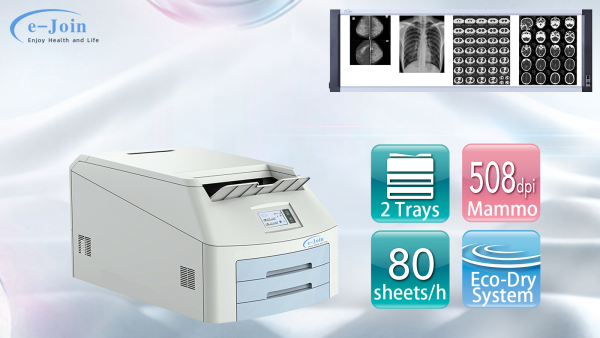In the ever-evolving landscape of medical technology, advancements are continually reshaping the capabilities and possibilities within various medical fields. Among these, radiography plays a crucial role in diagnostics, enabling healthcare professionals to visualize internal structures for accurate diagnoses and treatment plans. In recent years, the emergence of digital imaging technologies has significantly enhanced the efficiency and precision of radiographic processes. One such groundbreaking innovation is e-Join’s Medical Dry Thermal Imager (DT500, 508dpi) developed in China, which is poised to revolutionize the radiography industry.
e-Join’s Medical Dry Thermal Imager represents a paradigm shift in radiography equipment, offering unparalleled performance, versatility, and efficiency. Unlike traditional wet thermal imaging systems, which rely on chemical development processes and require dedicated darkrooms, e-Join’s dry thermal imaging technology eliminates the need for cumbersome and time-consuming procedures, streamlining the radiographic workflow.
At the heart of e-Join’s innovation lies its cutting-edge digital imaging capabilities. Leveraging advanced semiconductor technology and sophisticated image processing algorithms, the Medical Dry Thermal Imager delivers exceptional image quality with high resolution and clarity. This ensures precise visualization of anatomical structures, enabling healthcare professionals to make accurate diagnoses and treatment decisions swiftly.

Moreover, e-Join’s Medical Dry Thermal Imager offers remarkable versatility, catering to a diverse range of radiographic applications. Whether in general radiography, orthopedics, dentistry, or veterinary medicine, this innovative imaging system proves invaluable in various clinical settings. Its compact design and user-friendly interface further enhance its usability, allowing for seamless integration into existing radiology departments and practices.
One of the standout features of e-Join’s Medical Dry Thermal Imager is its rapid image acquisition and processing capabilities. With accelerated imaging speeds and instantaneous results, healthcare providers can expedite the diagnostic process, leading to faster treatment initiation and improved patient outcomes. Additionally, the digital nature of the imaging system facilitates easy storage, retrieval, and sharing of radiographic data, enhancing collaboration among medical professionals and supporting comprehensive patient care.
Furthermore, e-Join’s commitment to innovation extends beyond technological advancements. The company prioritizes user feedback and collaborates closely with healthcare professionals to continuously refine and optimize its products. This customer-centric approach ensures that the Medical Dry Thermal Imager not only meets but exceeds the evolving needs and expectations of the radiography industry.
In addition to its technical prowess, e-Join’s Medical Dry Thermal Imager stands out for its eco-friendliness and cost-effectiveness. By eliminating the use of chemicals and reducing energy consumption compared to traditional wet thermal imaging systems, it minimizes environmental impact while offering long-term cost savings for healthcare facilities.
As the global demand for efficient and reliable radiographic solutions continues to grow, e-Join’s Medical Dry Thermal Imager emerges as a game-changer in the field of medical imaging technology. Its innovative features, exceptional performance, and user-friendly design make it a preferred choice for healthcare providers seeking to elevate the standard of care in radiography.
In conclusion, e-Join’s Medical Dry Thermal Imager (DT500, 508dpi) represents a milestone in the evolution of radiography equipment, setting new benchmarks for quality, efficiency, and versatility. With its advanced digital imaging technology, rapid image acquisition, and user-friendly interface, it empowers healthcare professionals to deliver superior patient care while streamlining radiographic processes. As the industry embraces digital innovation, e-Join remains at the forefront, driving progress and shaping the future of radiography.

